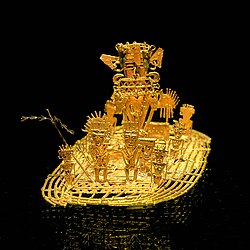
Back Goldfloß von Eldorado German Balsa muisca Spanish Chibchas#Mythe d'Eldorado French Balsa muisca Galician Muisca-vlot Dutch Чибча (плот) Russian Muisca raft Slovenian
| Muisca raft | |
|---|---|
 The Muisca raft | |
| Material | Gold, silver and copper |
| Size | 19.5 cm (7.7 in) x 10.2 cm (4.0 in) x 10.1 cm (4.0 in) |
| Created | 1295 – 1410 AD |
| Discovered | 1969 in Pasca |
| Present location | Gold Museum, Bogotá, Colombia |
The Muisca raft (Balsa Muisca in Spanish), sometimes referred to as the Golden Raft of El Dorado, is a pre-Columbian votive piece created by the Muisca, an indigenous people of Colombia in the Eastern Ranges of the Colombian Andes. The piece probably refers to the gold offering ceremony described in the legend of El Dorado, which occasionally took place at Lake Guatavita. In this ritual, the new chief (zipa), who was aboard a raft and covered with gold dust, tossed gold objects into the lake as offerings to the gods, before immersing himself into the lake. The figure was created between 1295 and 1410 AD by lost-wax casting in an alloy of gold with silver and copper. The raft was part of an offering that was placed in a cave in the municipality of Pasca. Since its discovery in 1969, the Muisca raft has become a national emblem for Colombia and has been depicted on postage stamps. The piece is exhibited at the Gold Museum in Bogotá.
© MMXXIII Rich X Search. We shall prevail. All rights reserved. Rich X Search